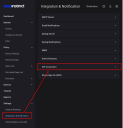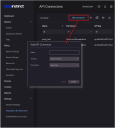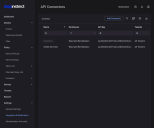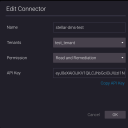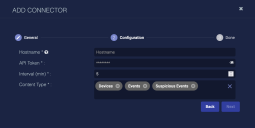Configuring Deep Instinct Connectors
Connectors allow Stellar Cyber to collect data from external sources and add it to the data lake. Review the content in this topic to understand what type of data can be collected and acted upon for this connector type.
Stellar Cyber connectors with the Collect function (collectors) may skip collecting some data when the ingestion volume is large, which potentially can lead to data loss. This can happen when the processing capacity of the collector is exceeded.
Connector Overview: Deep Instinct
Capabilities
-
Collect: Yes
-
Respond: Yes

-
Native Alerts Mapped: Yes
-
Runs on: DP
-
Interval: Configurable
Collected Data
|
Content Type |
Index |
API |
|---|---|---|
|
Devices |
Syslog, Assets |
https://<customername>.customers.deepinstinctweb.com/api/v1/devices |
|
Events |
Syslog, Alerts |
https://<customername>.customers.deepinstinctweb.com/api/v1/events/ |
|
Suspicious Event |
Syslog |
https://<customername>.customers.deepinstinctweb.com/api/v1/suspicious-events/ |
Domain
|
https://<Hostname> where <Hostname> is a variable from the configuration of this connector |
Response Actions
|
Action |
Required Fields |
API |
|---|---|---|
|
deep_instinct_asset and deep_instinct.id or deep_instinct_suspiciousevent and deep_instinct_maliciousevent and device_id |
https://<customername>.customers.deepinstinctweb.com/api/v1/devices/actions/isolate-from-network https://<customername>.customers.deepinstinctweb.com/api/v1/devices/actions/release-from-isolation |
Third Party Native Alert Integration Details
|
Devices |
This content is not applicable for alerts. |
|
Events |
Yes. Records with MITRE | ATT&CK values are de-duplicated, enriched with Stellar Cyber fields, and mapped to the Stellar Cyber |
|
Suspicious events |
No. |
For details, see Integration of Third Party Native Alerts.
Required Credentials
-
Hostname and API Token
-
To Collect, the API token must be created with at least READ_ONLY permission
-
For Response, READ_AND_REMEDIATION permissions are required
Locating Records
Use the following to query for records:
-
msg_origin.vendor:
deep_instinct -
msg_origin.category:
asset,endpoint -
msg_origin.source:
deep_instinct -
msg_class:
deep_instinct_asset,deep_instinct_maliciousevent,deep_instinct_suspiciousevent
Let us know if you find the above overview useful.
Adding a Deep Instinct Connector
To add a Deep Instinct connector:
- Obtain a Deep Instinct API token
- Add the connector in Stellar Cyber
- Test the connector
- Verify ingestion
Obtaining a Deep Instinct API Token
As part of this procedure, you specify the credentials of an account on the Deep Instinct server that will be used to retrieve data.
-
Log into your Deep Instinct Dashboard as an administrative user. Make note of the fully qualified domain name portion of the URL you used to log in (e.g., just mycompany.customer.deepinstinct.com). You will need this when you configure the Stellar Cyber connector.
-
From the Dashboard navigation pane, select Integration & Notification.
-
In the pane that loads, click the link for API Connectors, shown above.
-
Click the button to Create an API Connector.
-
In the Add API Connector dialog, create a name, select the Tenants you want to be able to use this API connector with Stellar Cyber and specify the Permissions. The minimum permission required is READ_ONLY. For Respond actions
 , you must include READ_AND_REMEDIATION permissions.
, you must include READ_AND_REMEDIATION permissions. -
Click OK to save the settings and create the API Key. The API Connectors pane displays.
-
Click the API key you created to display it, then copy the key. Save that key for use when you configure the Stellar Cyber connector.
Adding the Connector in Stellar Cyber
To add the Deep Instinct connector in Stellar Cyber:
-
Log in to Stellar Cyber.
-
Click System | Integration | Connectors. The Connector Overview appears.
-
Click Create. The General tab of the Add Connector screen appears. The information on this tab cannot be changed after you add the connector.
The asterisk (*) indicates a required field.
-
Choose Endpoint Security from the Category drop-down.
-
Choose Deep Instinct from the Type drop-down.
-
Choose whether you want to only Collect or also Respond.

-
Enter a Name.
Notes:- This field does not accept multibyte characters.
- It is recommended that you follow a naming convention such as tenantname-connectortype.
-
Choose a Tenant Name. The Interflow records created by this connector include this tenant name.
-
Choose the device on which to run the connector.
-
(Optional) When the Function is Collect, you can apply Log Filters. For information, see Managing Log Filters.

-
Click Next. The Configuration tab appears.
The asterisk (*) indicates a required field.
-
Enter the Hostname. This is the FQDN portion of the URL you used for your Deep Instinct dashboard login, above (for example, mycompany.customer.deepinstinct.com).
-
Do not include https in the field.
-
In the API Token field, enter the API key you created above.
-
Choose the Interval (min). This is how often the logs are collected.
-
Choose the Content Type. The logs for Devices, Events, and Suspicious Events are supported. Events are mapped to Stellar Cyber Alerts.
-
Click Next. The final confirmation tab appears.
-
Click Submit.
The new connector is immediately active.
Testing the Connector
When you add (or edit) a connector, we recommend that you run a test to validate the connectivity parameters you entered. (The test validates only the authentication / connectivity; it does not validate data flow).
For connectors running on a sensor, Stellar Cyber recommends that you allow 30-60 seconds for new or modified configuration details to be propagated to the sensor before performing a test.
-
Click System | Integrations | Connectors. The Connector Overview appears.
-
Locate the connector that you added, or modified, or that you want to test.
-
Click Test at the right side of that row. The test runs immediately.
Note that you may run only one test at a time.
Stellar Cyber conducts a basic connectivity test for the connector and reports a success or failure result. A successful test indicates that you entered all of the connector information correctly.
To aid troubleshooting your connector, the dialog remains open until you explicitly close it by using the X button. If the test fails, you can select the button from the same row to review and correct issues.
The connector status is updated every five (5) minutes. A successful test clears the connector status, but if issues persist, the status reverts to failed after a minute.
Repeat the test as needed.
If the test fails, the common HTTP status error codes are as follows:
| HTTP Error Code | HTTP Standard Error Name | Explanation | Recommendation |
|---|---|---|---|
| 400 | Bad Request | This error occurs when there is an error in the connector configuration. |
Did you configure the connector correctly? |
| 401 | Unauthorized |
This error occurs when an authentication credential is invalid or when a user does not have sufficient privileges to access a specific API. |
Did you enter your credentials correctly? Are your credentials expired? Are your credentials entitled or licensed for that specific resource? |
| 403 | Forbidden | This error occurs when the permission or scope is not correct in a valid credential. |
Did you enter your credentials correctly? Do you have the required role or permissions for that credential? |
| 404 | Not Found | This error occurs when a URL path does not resolve to an entity. | Did you enter your API URL correctly? |
| 429 | Too Many Requests |
This error occurs when the API server receives too much traffic or if a user’s license or entitlement quota is exceeded. |
The server or user license/quota will eventually recover. The connector will periodically retry the query. If this occurs unexpectedly or too often, work with your API provider to investigate the server limits, user licensing, or quotas. |
For a full list of codes, refer to HTTP response status codes.
Verifying Ingestion
To verify ingestion:
-
Click Investigate | Threat Hunting. The Interflow Search tab appears.
-
Set the Indices to match the type of content you collected:
-
For Devices, change the Indices to Syslog or Assets. Note that hosts discovered through this connector show Deep Instinct as a data source.
-
For Events, change the Indices to Syslog or Alerts.
-
For Suspicious Events, change the Indices to Syslog.
-
